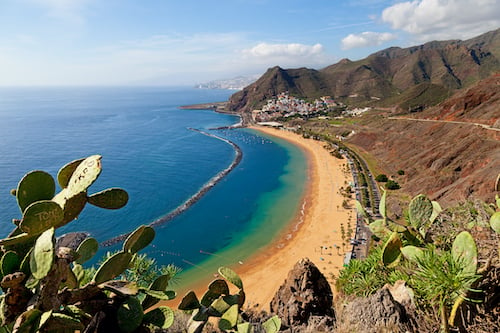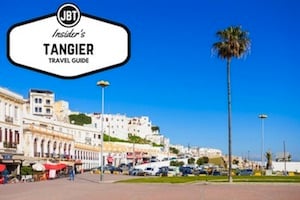Many visitors fly into Morocco perhaps not even aware that travel to and from Morocco’s neighboring countries is possible! Anyone can easily extend their visits to include Spain, the Spanish exclaves of Ceuta and Melilla, the UK exclave of Gibraltar, or even the Canary Islands. Though travel to Mauritania and the disputed Moroccan territory Western Sahara takes more planning, and considerable caution, adventurous travelers can even add these stops to their Morocco itinerary.
Traveling to and from Spain
Only nine miles of water separate Morocco and Spain, making travel between the countries inexpensive and uncomplicated. Most travelers will only need their passport that’s still valid for 6 months, but no special visas, to cross either border. Many ferries, some with accommodation for cars, cross the Strait of Gibraltar daily between Spain and Morocco. Most visitors travel between Tarifa, Spain, to Tangier. Ferries are runs by competing companies, FRS and Intershipping. Ferry service is also available from Algeciras, Almeria, and Malaga in Spain. There is also service from these cities to Melilla and Ceuta on the African continent. However, they are generally 2-4 hours in length for the crossing, making these more of a secondary option for most travelers.
You can read more about crossing the borders between Morocco and Europe by ferry here: https://www.journeybeyondtravel.com/morocco/ferry
Flights from Spain reach several Moroccan cities, including Casablanca, Marrakech and Fez.Ceuta and Melilla are special cases, as they are located on the Moroccan mainland, but are both independent Spanish territories and part of the EU. Border guards check passports at the city border.

Traveling to and from the Canary Islands
These Spanish islands, closer to Morocco than they are to mainland Spain, are known for their beautiful beaches and party atmosphere. Flights from Agadir, Casablanca and Marrakech to the Canaries depart daily, and passport requirements are the same as they are for mainland Spain.
Traveling to and from Gibraltar, UK
The British territory of Gibraltar sits at the entrance to the Mediterranean Sea between Spain and Morocco. With its looming Rock of Gibraltar, network of caves and curious dolphins and Barbary macaques, Gibraltar is a popular and compact spot for unique natural sights and the ease of moving around in an English-speaking culture. Ferries from Tangier travel to Gibraltar twice a week and take about two hours. Traveling over Gibraltar’s borders requires immigration and customs checks with the UK. Americans, Canadians and British citizens need a valid passport, but not a visa to enter.
Exploring the Western Sahara
A word of caution: The Western Sahara is a disputed territory which Morocco claims. There are some state warnings about traveling to far flung region in the deep south of Morocco, boarding Mauratania. Travelers are at some risk of threats from terrorism, public unrest and landmines, though in recent years it has been quite safe. Still, it’s best to register your travel plans with your country’s embassy in Morocco before entering.
Morocco controls most of Western Sahara, though an ongoing struggle for independence makes for an unstable environment. A ceasefire has been in place since 1991. Neiither the United States nor the United Kingdom has travel restrictions in place. Experienced travelers with common sense can cross the border into this territory to explore sparsely-populated stretches of the Sahara. Organized tours may be the safest plan, though touring by private vehicle is allowed in many areas. Please note that many areas, however, require police escort. Politely follow instructions from military personnel.
Americans, Canadians and Europeans may enter Western Sahara with a passport.
Crossing into Mauritania
CAUTION: Though there are currently no travel restrictions for Western visitors, Mauritania can be an unstable place with a high risk of terrorist activity, civil unrest and landmines. Register with your country’s embassy in Nouakchott upon arrival and do not venture far from populated areas. Of the possible place to travel to and from Morocco’s neighboring countries, this definitely takes the most planning.
Though Mauritania is not for the novice traveler, those willing to take extra safety precautions can experience a vast desert land with ancient cities and warm hospitality. Avoid the country’s borders with Algeria and Mali, instead spending time in cities close to Morocco: Atar, Chinguetti, Nouadhibou and the capital of Nouakchott.
Citizens from North America and Europe need visas to enter Mauritania. Though it may be possible to get a 24-hour visa turnaround in Rabat. However, to be safe, apply for a visa in your home country a few months in advance. The U.S. State Department requires a yellow fever vaccination for visitors.
From Morocco, flights leave Casablanca for Mauritania. Overland, cars can cross the border between Western Sahara and Mauritania, though getting to that point for independent travelers would require negotiation with local guides who understand the frequently changing conditions at the border. The land border is sometimes closed without warning.
Please note: If you glanced at a map, no doubt you noticed that Morocco shares a long land border with Algeria to the east. This land border between Morocco and Algeria has been closed for a few decades and the two governments continue their dispute over the Western Sahara. Furthermore, the U.S. State Department warns against travel in parts of Algeria due to ongoing violence.
When you are still in the planning stages of your Moroccan adventure, consider travel to and from Morocco’s neighboring countries! Especially if you’re flying from farther afield places such as Australia, New Zealand, or North America, it can make a lot of travel sense to maximize your stay in this part of the globe. This way, you can not only see the best of what Morocco has to offer, but the entire region!
Originally written by Brinda Gupta. Updated by Lucas Peters.










